Learn how to optimize how shoppers find your products in a way that will resonate with their intrinsic behavior.

Learn how to optimize how shoppers find your products in a way that will resonate with their intrinsic behavior.
Imagine a world where you instantly get matched to the products you like or love.
We’ve all heard of Tinder, right?
If not, how about OkCupid, Bumble, Grindr?
Now think of dating apps but for shoppers: You swipe left for a pair of Nike’s you don’t like the color of. You swipe right for a pair of Puma’s that look just right.
The brand collects zero-party data on what you like and don’t like. Meaning, they stay within data privacy laws (keeping the end-customer safe) while still personalizing the product discovery experience (keeping the end-customer coming back).
But if this is the future – what does product findability look like today?
The bitter truth is that product findability for eCommerce right now is both limited and immature.
But as a retailer, you’re faced with this challenge every day. Your shoppers are suffering from an overload of product choices. They struggle to find products that match their search queries.
When landing on a webshop, they often also struggle to have a seamless browsing experience free of Dark Patterns or bad UX.
In light of this, many brands are experimenting with things like conversational search, omnichannel promotions, and personalization on-site designed to increase the findability and visibility of their products.
We’re not that far off from the matchmaking scenario above. Where customers are in complete control of their journeys and can find and explore products with the flick of a finger.
And the first step to achieving this?
You learn to enhance your product findability for eCommerce. This article tackles this challenge through the lens of psychology (i.e., designing a better UX).
With the advice of guided selling experts and a dash of behavioral psychology, you’ll be able to enhance your product findability for:
I’ll show you how.
Product findability is how shoppers search, discover, and find the products made for them. This means there’s a three-pronged challenge for enhancing your product findability.
Your shoppers need to:
And this process needs to happen in a streamlined and frictionless fashion or – I hate to break it to you – your shoppers will bounce right on out of your webshop.
Think about your brick-and-mortar store. Maybe you have sales clerks to assist your customers. Maybe you’ve integrated aspects of the phygital, whereby you have the technology to facilitate product findability like touchscreens, virtual dressing rooms, etc.
Or maybe you don’t own the in-store customer experience at all, and your co-branded products are sold in a wholesale environment.
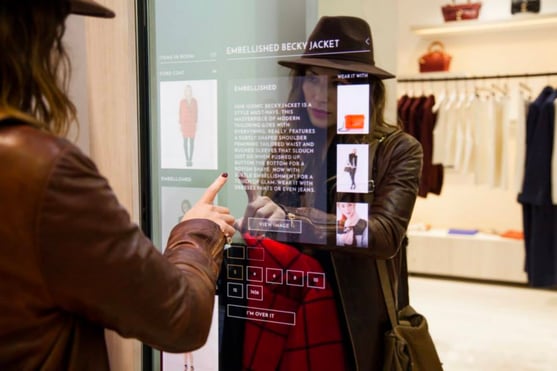
Whatever your offline context looks like, product findability is simple. It:
In short, for traditional retail, product findability is all about entering a store, browsing, or asking a sales clerk for help.
This behavior looks very different online which is why we’re going to take you through how to do it.
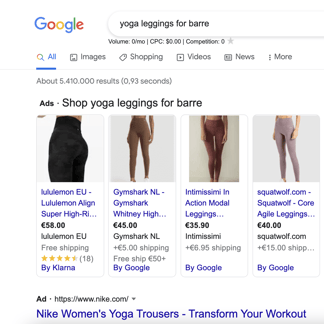
Getting this right will not only optimize the layout of your webshop in line with your customer’s behavior. It will also ensure you meet your KPIs like revenue uplifts and product sales.
And if that wasn’t enough to get you going –
You’re a merchandiser, CRO specialist, digital marketer, or eCommerce manager. Or maybe you’re just overall in charge of creating a frictionless customer experience on your webshop.
Whatever part of the journey you’re in charge of – from taxonomies to retargeting – it’s up to you to make your products:

Why is this important? To help my case, I thought I’d bust out some product findability insights for you:
Stats are all fine and dandy, but what do they mean? To put it bluntly, product findability starts:
And ends with retargeting, re-engagement, or nurturing:
The sheer amount of choice that exists in the market means that you are competing for product findability with thousands of other brands selling the same products.
To enhance your product findability means cutting through the noise, relieving choice overload, and placing your products on a pedestal.
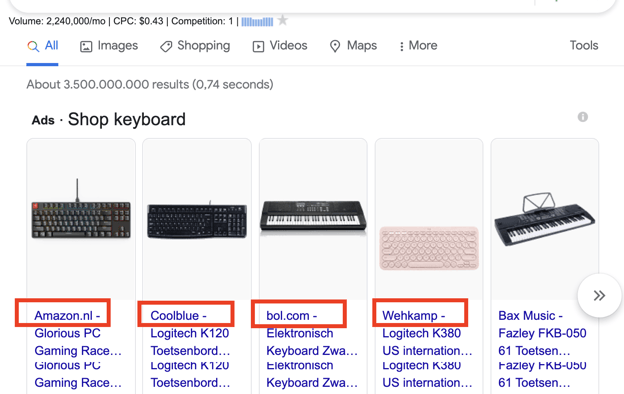
This is how many choices come up when I type into Google “Keyboard”, from brands to style, and even to the product itself.
To do this, you need to look at consumer behavior online, and what kinds of cognitive processes are involved in how they find your products.
And for this to make sense, we enter the realm of consumer psychology.
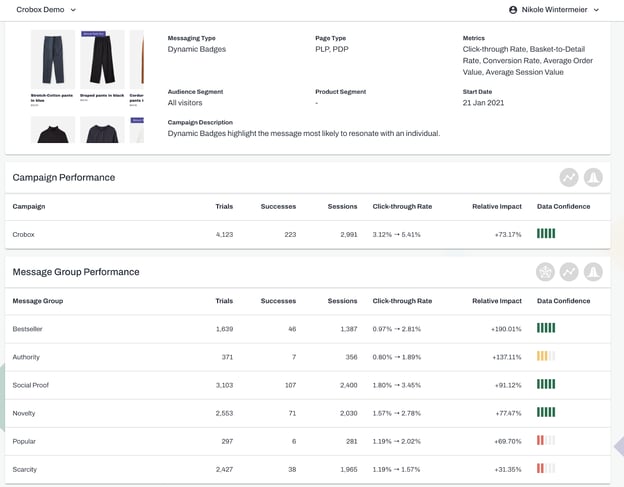
Experiments running on the Crobox app for Dynamic Messaging look at the best performing behavioral message. Or, in other words, what psychological principles drive behavior on-site.
Psychology and product findability are a question of UX. In fact, you can’t think of optimizing the eCommerce experience without taking psychology into account.
That’s because the way customers shop online is about making quick choices by leveraging cognitive biases.
Here’s a crash course in consumer decision-making for you.
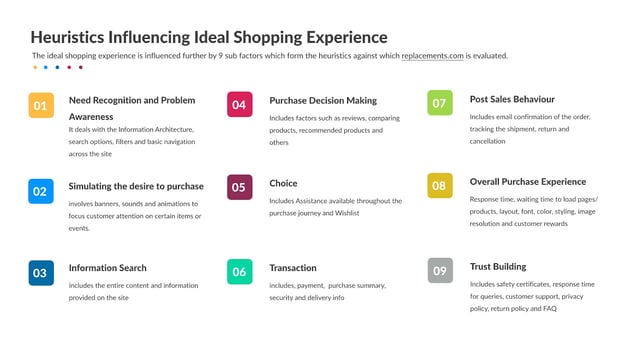
Source: Heuristic evaluation of an eCommerce site
Heuristics are mental shortcuts our brain uses to make decisions. This allows us to act fast, reduces cognitive effort, and simplifies problems.
Online, these heuristics are often prompted by,
Each of these heuristics are things you need to take into account when enhancing your product findability on-site. We’ll take a look at just how later on.

Patagonia leverages sustainability icons to appeal to the green shopper on a subconscious level. These are cognitive shortcuts they use to promote their products.
Once you have a handle on how your customers leverage their mental shortcuts to make shopping decisions, you can begin to optimize the search, findability, and discovery experience online.
Choice Overload has roots in a psychological principle: Too many choices can cause decision-stress and hesitation in a shopper’s subconscious.
Reducing choice overload means facilitating decision-making. And if you can facilitate decisions, you can create a more stress-free product findability journey.

Cotton On focuses attention on their new styles in an interactive banner. They do this to reduce choice overload and enhance product findability.
Once again, this means studying your customer’s heuristics –
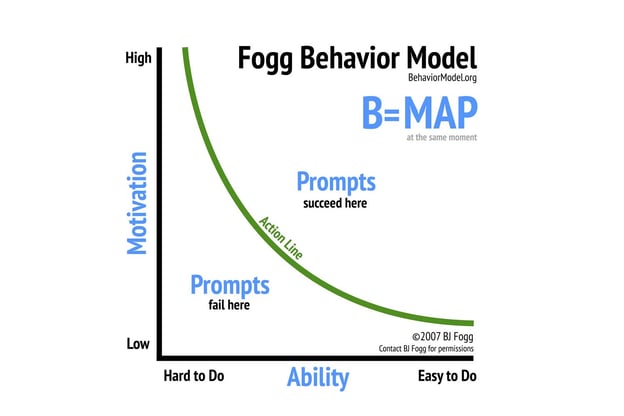
Fogg’s behavior model explains the theory behind nudges (i.e., what he calls ‘prompts’).
So on one end we have your customer’s decision-making (heuristics), and on the other how these choices can lead to choice overload if you don’t prompt them in the right way.
Prompts and cues can also be called nudges.
Nudge theory is another big realm of research in the psychological world. Nudges are basically tiny changes you make to the choice architecture to guide your shoppers through the conversion funnel.
This works by,
Nudge theory is how tiny changes to the choice architecture will affect behavior.
It means that through a psychological theory alone, you can actually enhance the product findability journey.

At Crobox, you can choose which nudges to display where and build out your entire nudge marketing campaigns by yourself. Nudging behavior will increase the chances of people finding, exploring, and buying your products.
For more, read our ebook on Nudge Marketing:
Now that you know why psychology is key in enhancing your eCommerce product findability, how do you go about optimizing this entire journey?
The way your customers make shopping decisions will influence their path to purchase – from awareness to consideration. Here’s how you can optimize these choices and make your products both easy to find and visible.

Did you know that 92% of all search queries are long-tailed keywords?
What does this mean for your product taxonomy? Do you change your category “Dress” to “Red dress with sequins” because that’s what customers are typing?
No. You organize your taxonomies with categories that help customers browse on “Red” and “Sequins”.
Depending on your brand and product offering, you can also begin to categorize based on your customer’s psychographics. In other words, the lifestyles of your customers.
For example, “Dresses for going out”, “Spring dresses”, “Wedding dresses”, etc.

Or, as Revolve does, ‘shop by style’.
Product findability is about how people search and discover your products, remember?
This means your taxonomy is one of the first lines of attack to make product findability more intuitive and appealing.
The best kind of taxonomy UX will learn from shopper’s behavior in order to optimize the product offering. To do this, dive into your eCommerce product analytics to see which products perform, and how customers are engaging with them.
To optimize your product taxonomy, have a look at Plytix’s PIM.


Filtering is one sure-fire way to make product findability just that more autonomous, interactive, and representative of the in-store experience.
After all, shoppers narrow down their search in-store by looking for categories or asking sales clerks to guide them through your collection.
Online, you can actually do this in a more concise and information-driven way.
Take Nike’s filter. Because their customers are driven by the technology and sport-specific use of their shoes, they leverage this in their filter.
This helps to advance the search query and collects valuable data on what kinds of filters your customers use to better browse your products.

Hick’s Law is the mathematical explanation that shows how the number of choices increases the decision-making time. Explaining why choice overload works logarithmically.
Which also explains the science behind filtering. If you can help your customers narrow down your product collection they can:
All with the aim of making the UX less time-consuming and more interactive. Filtering also leverages the Endowment Effect. I.e., the more a user can touch, interact, or play around with their experience, the more likely they’ll be to convert.
Check out Attraqt for more on how to advance search queries in a filtering bar.
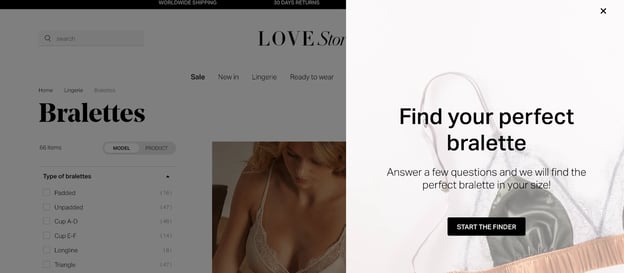
To take your customers from awareness to consideration and make your products easier to find, try leveraging a Product Finder.
This is basically a quiz that asks a series of questions to determine your customers’ shopping goals. Based on their answers, it will recommend a perfect product.
We’ve written a lot about the psychology of product finders. To give you a quick debrief, here are two psychological principles that product finders leverage to enhance product findability:
1. Goal Priming
This is when an individual is triggered to act by cues in line with their original goal. Product Finders offer personalized recommendations based on the customer’s buying behavior to prime the ultimate goal (i.e., a click or purchase).
This is basically a nudge in action. Customers are more inclined to make product choices because they are facilitated in reaching their goals, e.g., Love Stories CTAs ‘Explore all styles in your size’, and ‘You might also like’.
2. Goal Gradient Effect
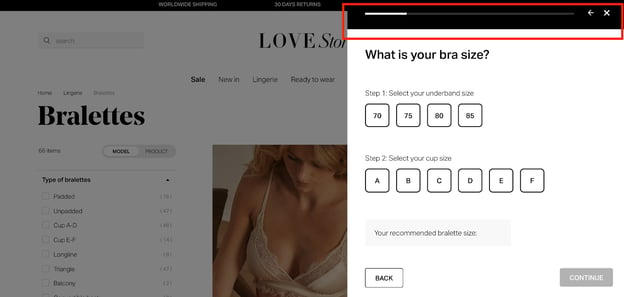
This is the theory that suggests individuals are more motivated to carry on when they see how close they’ve come to their goal (e.g., a progress bar).
To nudge shoppers through the funnel in this way provides a transparent overview of their journeys (and how much is left to go) and encourages commitment and consistency throughout the product discovery journey.
This is why product finders hit the nail on the psychological head – but is also a heuristic that will alleviate hesitation and regret.
To leverage and scale your own Product Finder on your webshop, go to the Crobox Product Finder.

Dynamic Messages can be things like product badges, notifications, or overlays that show more information about your products or brand.
In doing so, they:
This will enhance the product findability experience because Dynamic Messages often leverage heuristics or cognitive biases to ensure the most personalized messages are shown to the customer.
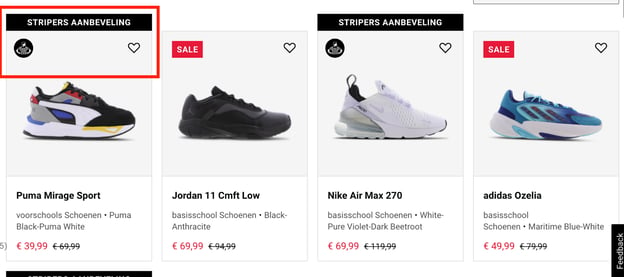
Dynamic Messages are basically behavioral nudges. They aim to drive purchase behavior by pointing out things that matter about the product and brand. E.g., For Foot Locker:

Scarcity is the behavioral principle that when things are limited, exclusive, or rare, they seem more desired.
Foot Locker can test their messages and make them dynamic based on who’s looking at them.
For instance, a shopper who is more likely to respond to Social Proof (e.g., “Bestseller”) messaging will be delivered more Social Proof messages (e.g., “This item has been bought X times!”) to nudge their behavior.
Leverage overlays, badges, or product stories yourself with Crobox’s Dynamic Messaging.
The rise of consumer psychology in eCommerce goes hand-in-hand with delivering the best customer experiences.
Personalization always starts with understanding how the end-customer makes choices, to be able to find or recommend them the best products.
If Tinder for products is the future of enhancing the findability and visibility of your product offering, then it’s time to put in the grunt work and learn about your customers’ behavior.
Psychology can offer you unique ways to optimize your UX, strengthen your merchandising, and personalize the customer journey from awareness to purchase.
Want to learn more?